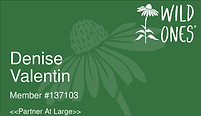


Native Plant Wildlife Gardens and Their Importance
Why are wildlife gardens important?
Wildlife gardens are important because they allow wildlife to survive in today's unwelcoming and harsh environments. Humans have become less connected to nature and the outdoors. Did you know that wildlife populations have plummeted 73% between 1970 and 2020 (Living Planet Report 2024 by the World Wildlife Fund).
I have been living in South Florida for almost 30 years, and there is noticeably much less wildlife here because of habitat loss and degradation due to over-development and reckless higher human populations. We tend to not care about things we do not understand, and that includes damaged ecosystems and lowered ecosystem services provided by nature.
Would it not be great to help save the dwindling monarch butterfly population by planting a few native plants their caterpillars love in your yard? Or add some native trees to provide shade to you and a place for wildlife to live and hide from predators. Having your own wildlife garden and watching wildlife provides benefits to all who visit them.
Did you know that watching and listening to birds brings calm to our lives? Just sitting in nature can have a positive impact on our health. I cannot always go to a park because of the heat and humidity, but I do have native plants in my garden and watch the birds, bees, butterflies, dragonflies, squirrels, lizards, spiders, and my neighbor's cat (who does not attack the birds as they attack her).

Why are native plants important to use in your garden?
Native plants need to be used in wildlife gardens because they need less maintenance, grow stronger in their native climate, and support native wildlife. Native wildlife prefers native plants for their food sources. Native plants also help keep out non-native plants which can harm the biodiversity in native wildlife (this means we have different types of wildlife, not just one). Non-native plants can grow fast and overtake native plants in local natural areas.
Did you know that billions of dollars are used to clear and eradicate non-native plants in waterways, fields, open forests, and swamps around the world. Grass is not your friend -- it needs large amounts of water unlike native plants. Grass also needs to be mowed regularly -- native plant gardens need no mowing, just trimming (make sure you read about the maintenance needed by any plants you purchase).
What do you need to provide for wildlife in your garden?
+FOOD
Native plants are a necessity and should be 70% or more of the plants in your wildlife garden (according to the National Wildlife Federation). Local wildlife eats both the insects and plants in your yard. You can supplement their food supply with seeds, berries, and nectar.
+WATER
Clean water is essential for wildlife to survive. Water is also important for frogs and insects to lay eggs. Add a shallow dish of water, small fountain, hanging water holder, or a bird bath and watch nature in action.
+COVER
Create as many areas with a variety of plants for wildlife to live and hide from predators and the weather. Remember that leaves provide food and a living space for some wildlife. Make sure you add groundcover, flowers, trees, and bushes in different areas of your yard.

Photo by A. G. Rosales
+SPACE
Wildlife needs space to find mates, build nests, and raise their young.
Container Gardening?
For those who live in apartments and condos, did you know you could have a container garden of native plants to help out local pollinators? For more information on container gardening, check out the article in the National Wildlife Federation Blog.